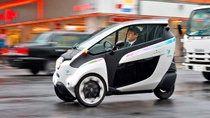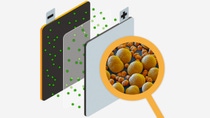24.4 billion $
is the expected value of e-bike sales worldwide by 2025. That would be an increase of more than 50 percent on the 2016 figure.

Focus
Concepts to keep traffic moving and improve quality of life
Novice in mediji
Automobiles stand bumper to bumper, and everywhere horns are blaring and the air is thick with fumes. From Bucharest to Jakarta, traffic jams extending for kilometres are a fact of life. For instance, in Mexico City, which tops the international traffic jam league, congestion lengthens the average daily journey time by 66 percent. This means, for example, that instead of 60 minutes you need around 100.
To remain liveable and be fit for the future, cities must become sustainably mobile – this is one of the development goals of the United Nations’ Agenda 2030. “If you want to ensure a better quality of life and cleaner air in cities as quickly as possible, you have to be in favor of shared mobility,” says Professor José Viegas, a Portuguese transportation expert. Until 2017, he was head of the International Transport Forum, the transportation policy think tank of the Organization for Economic Cooperation and Development (OECD). The motto is renting and sharing, not possessing.
Traditional transportation behavior is going to be changed by shared mobility offerings.”
In countries like China, which set records for smog, sharing is becoming an important solution for mobility. Not only is car-sharing seeing a boom, with forecast growth rates of 45 percent by 2025, but bicycle rental systems are likewise flourishing. In just two years, companies like Mobike have placed 19 million brightly colored rental bicycles in China and hundreds of other cities on every continent.
Transportation experts are in agreement here. “Traditional transportation behaviour is going to be changed by shared mobility offerings and easier switches between transportation modes,” says Claire Depré, Head of the Unit for Sustainable and Intelligent Transport at the Directorate General for Mobility and Transport of the European Commission in Brussels. Commuters will drive by automobile to the city limits, where they will change onto a train. Within the city, they will continue their journeys by urban railway or subway and then switch to a bus or rental bicycle for the last stretch to their places of work.
Three cities that are taking a new direction to get their residents more smoothly from A to B.
Local public transportation has been free for residents since 2013. Free travel for all is to be made available in other parts of Estonia soon.
+ enables the socially disadvantaged to get around
+ better air, less noise
+ less congestion
- high cost to the city budget
The longest urban aerial cable car system in the world connects La Paz with the workers’ housing estate of El Alto. Seven lines are in operation, and four more are at the planning and construction stage.
+ low fares
+ cuts road congestion
+ densest urban cable car network in the world
+ reduces rush-hour journey times by around two-thirds
- operating radius is limited to distances of less than 5 kilometers
Dedicated routes have been set up on highways for the bus rapid transit (BRT) system known as Metrobüs. Large express buses run on these routes every half a minute
+ one of the fastest service frequencies worldwide
+ BRT is also being used successfully in other Asian cities, such as Jakarta, Indonesia, and Guangzhou, China.
- buses are often overcrowded
New digital mobility services will make it easier, more efficient and cheaper to get from A to B, as is happening in Helsinki, Finland, a pioneer in this area. Since 2016, people living in the Finnish capital have been able to use an app called Whim for intelligent travel planning across all transportation modes. Taxis, trains or car-sharing are booked and paid for through a common digital platform. What are known as Mobility-as-a-Service (MaaS) solutions, like Helsinki’s, are being trialed worldwide in cities that suffer from heavy traffic, such as London, Los Angeles and Singapore. The vision is one of less traffic but more mobility.
“Like digital networking, electromobility is creating possibilities that nobody can ignore,” Viegas says. This is because, in e-mobility, both startups and the R&D departments of major companies worldwide are surpassing themselves in coming up with innovations. Thanks to batteries that are longer-lasting and have a wider range, plus a well-developed network with smart charging stations, e- mobility is an important factor in cutting traffic-related greenhouse-gas emissions, if the electricity comes from renewable sources. Across the whole E.U., these gases that are harmful to the climate are set to be reduced by 80 percent by 2050, compared with 1990 levels. “This is why the Commission is driving the electrification of all transportation modes, on land and water and in the air,” says Depré, the E.U. transportation expert.
24.4 billion $
is the expected value of e-bike sales worldwide by 2025. That would be an increase of more than 50 percent on the 2016 figure.
There is still room for improvement in the sales figures. In 2017, a total of 54,492 plug-in hybrid and electric automobiles were sold in Germany, the country with the fourth-highest number of sales in the world. The market leader, with 777,000 vehicles, was China, which had toppled the United States from top position in 2016. China is using a quota that obliges automobile manufacturers to make clean vehicles from 2019, as well as offering financial incentives for buyers to boost the 2.7 percent market share that e-automobiles already have.
One potential solution for a sustainable Transition in transportation is often underrated – the electric-powered bicycle. This makes the new, old transportation mode attractive to commuters, for, as the German Federal Environment Agency says, e-bikes are usually faster than automobiles in city traffic over distances of less than 10 kilometers. Up to 30 percent of automobile journeys in conurbations could be made by bicycle, experts estimate. It is no wonder, then, that the e-bike market is growing at record speed. Navigant Research, an international market research company, expects global e-bike sales to rise from more than $15.7 billion in 2016 to some $24.4 billion in 2025.
Cities such as traffic-plagued Barcelona are already steering a course toward sustainable mobility. City and transportation planning are being thought through together. The city aims to create 300 kilometers of new bicycle paths, buses are to run more frequently and more stops are to be set up. However, the heart of the reform lies in what are known as superblocks – squares measuring about 400 meters by 400 meters, from which traffic will largely be excluded. Automobile drivers – with the exception of residents and delivery vehicles – will be diverted around the outside, freeing up the roads within the blocks for pedestrians and cyclists. Residents and passersby will receive a new space in which they can meet up and have a stroll.
How long does it take to charge an electric car battery, how far can I drive on a single charge, and what are the costs? BASF research into high performance lithium-ion battery materials is contributing to improvements in all three areas – shaping the way for e-mobility to become suitable for daily use.
We aim to double the real driving range of medium-sized battery- powered cars from 300 to 600 kilometers by 2025.”
Most modern electric vehicles are powered by lithium-ion batteries. It currently takes on average more than 60 minutes to fully charge a medium-sized electric car and the average range under real driving conditions is 300 kilometers.
The battery consists of cells, each with a positive and negative electrode. The cathode is made of Nickel Cobalt Aluminum (NCA) or Nickel Cobalt Manganese (NCM), the anode of graphite. Lithium-ions carry the battery’s charge between the electrodes, creating electric energy which is converted into mechanical energy to drive the vehicle.
The properties of the cathode materials are critical to the charging time and energy content of the battery. The individual particles (here NCM) are just micrometers in size.
BASF is partnering with its customers to help them reach these ambitious e-mobility targets by adjusting chemical composition, form and structure, as well as production process of the cathode materials.






